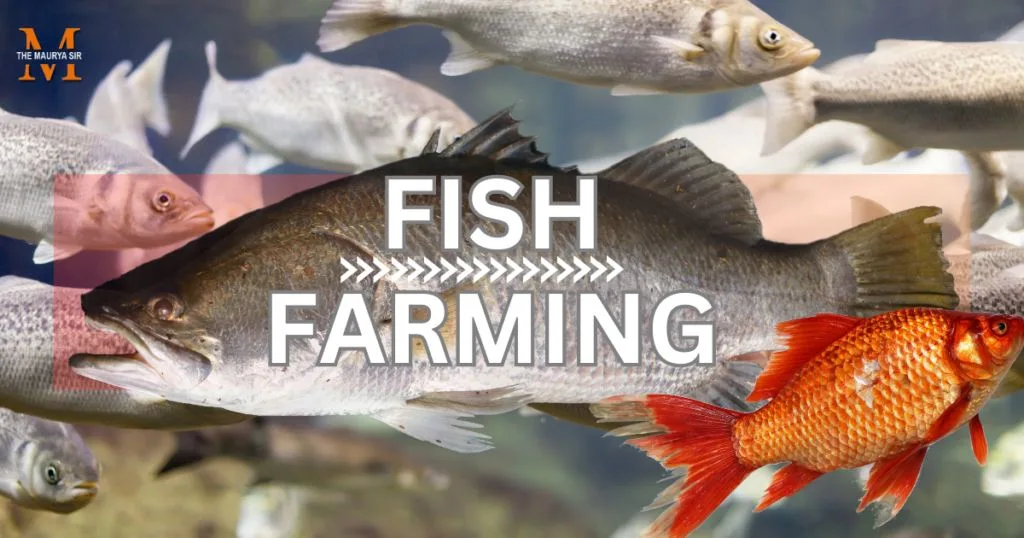Do you want to create a fish farm but are unsure of where to start? Fish farming can be a successful and rewarding endeavor, but it requires careful planning, expertise, and understanding. In this post, we’ll walk you through the steps involved in starting up a fish farm, from locating a good location to selecting the best fish species, building ponds, and monitoring your farm for maximum output. This manual includes something for everyone, whether you’re a novice or an expert farmer.
1. Introduction to Fish Farming
1.1 What is Fish Farming?
Fish farming, commonly referred to as aquaculture, is the process of growing fish in ponds or tanks for human consumption or other reasons. In a controlled environment, this procedure comprises managing fish mating, feeding, and growth.
1.2 Average of Fish Farming:
Compared to traditional fishing techniques, fish farming provides a number of benefits, including:
- The capacity to farm fish in locations where traditional fishing is not feasible, such as landlocked areas or regions with adverse weather conditions;
- A consistent supply of fish for consumption and commercial uses;
- A more regulated environment that can produce larger yields and faster growth rates;
- Lessening the strain on wild fish populations, which could aid in the preservation and protection of aquatic ecosystems
1.3 Types of Fish Farms:
There are various types of fish farms, including:
- Page systems, where fish are raised in net cages or pens in natural bodies of water;
- Pond systems, where fish are raised in sizable ponds or artificial lakes;
- Raceway systems, where fish are raised in long, narrow channels;
- Recirculating aquaculture systems (RAS), which recycle and filter water to maintain optimal water quality;
- Integrated systems, combine fish farming with other agricultural practices, like rice or prawn production.
2. Site Selection for Fish Farming
2.1 Factors to Consider in Site Selection:
It is crucial to take into account various aspects while choosing a location for a fish farm, including:
- Water source and quality
- Soil type
- Topography
- Climate
- Accessibility
- Legal requirements and regulations
2.2 Water Source:
Fish farming depends heavily on the quality and accessibility of water. Rivers, lakes, groundwater, and even public water systems can serve as fish farming water sources. Ensuring the water source is clean and appropriate for fish farming is crucial.
2.3 Soil Type:
The construction and functioning of the fish farm may be impacted by the type of soil at the location. Problems with water retention and quality can result from soils that are either excessively permeable or too impermeable. To find out if the soil is suitable for fish farming, it is crucial to undertake soil tests.
2.4 Topography:
The layout and design of the fish farm may be impacted by the site’s topography. The location should be somewhat flat and free of barriers to enable the installation of ponds or tanks.
2.5 Climate:
The location’s climate may affect the fish that can be farmed there as well as the necessary management techniques. When choosing a location for a fish farm, it’s crucial to take weather conditions like temperature, precipitation, and wind into account.
2.6 Legal Requirements:
When choosing a location for a fish farm, it may be necessary to consider any applicable laws and regulations. Environmental impact studies, zoning regulations, and permits are a few examples of these.
3. Fish Species Selection
3.1 Native vs. Non-Native Species:
Whether a fish species is indigenous to the area or not should be taken into account when choosing it for a fish farm. If non-native animals escape or are released into the wild, they may have a harmful effect on the environment.
3.2 Warm-Water vs. Cold-Water Species:
Depending on their preferred temperature, fish species can be categorized as warm- or cold-water species. It is crucial to choose a species that is compatible with the site’s environment and water temperature.
3.3 Species Adaptability:
Regarding diet, ambient conditions, and water quality, different fish species have varied needs. It’s crucial to choose a species that can adapt to the environment.
3.4 Market Demand:
In fish farming, market demand is a crucial issue to take into account. Before beginning a fish farm, farmers must determine the market demand for their fish products. To ascertain the kinds of fish that are in demand and the optimal price to charge for their products, fish farmers should research market trends and consumer behavior. This information will assist the farmer in production planning, marketing strategy enhancement, and profit maximization.
4. Pond Construction and Management:
The most important components of fish farming are pond building and management. Fish will grow and produce to their full potential in a well-managed and constructed pond. We will cover a variety of pond management and building topics in this section.
Like to More Read:
Types of Hairstyles for Girls: Choosing the Best Style for You
Top 10 Beauty Tips for Women to Enhance Their Natural Glow
Top 10 High-Protein Foods for a Healthy Diet
4.1 Pond Design and Construction:
The design and building of the pond should be in accordance with the needs of the fish species that will be raised there. A pond’s size, shape, depth, water flow, and drainage system should all be appropriate. The construction procedure should adhere to accepted standards, and the materials employed should be of the highest caliber.
4.2 Pond Preparation:
The pond needs to be readied to provide the best conditions for the fish before being stocked. Pond preparation is clearing the pond of undesired trash, plants, and predators. Lime or other chemicals should be used to treat the pond bottom to lessen the likelihood of dangerous germs.
4.3 Stocking the Pond:
For fish farming to be effective, the pond must be stocked with the appropriate species of fish. The stocking density and timing should be carefully planned to guarantee that the fish have adequate room and food to grow. Additionally, fish producers should think about the cost of stocking as well as the size and quality of the fish.
4.4 Feeding and Nutrition:
Fish require nourishment and feeding in order to develop and survive. The amount of fish feed should be determined by the size and age of the fish, and it should be nutritionally balanced. To avoid waste and overfeeding, the meal should be dispersed uniformly throughout the pond. To augment their fish feed, fish farmers can employ natural sources of food like plankton, insects, or algae.
4.5 Water Quality Management:
For fish to stay healthy and grow, water quality needs to be kept high. To make sure the water quality reaches the necessary criteria, fish producers should test the water frequently. Regular monitoring of the pH, temperature, dissolved oxygen, ammonia, and nitrite levels should be done. Any irregularity should prompt the necessary corrective action.
4.6 Disease Prevention and Treatment:
It is the farmer’s duty to prevent and control the many diseases that fish are susceptible to. Fish farmers need to keep their ponds clean, quarantine new fish before stocking them, and use vaccines or treatments to fight off illnesses. The fish farmer must quickly isolate and cure any ill fish.
4.7 Harvesting and Marketing:
The last stages of fish farming include harvesting and marketing. To guarantee that the fish are the right size and weight, they should be harvested at the proper time. The fish should be sent to the market as soon as possible after being harvested to guarantee that they stay fresh. Fish farmers have a variety of marketing options available to them, including direct sales, merchants, and wholesalers.
5. Business Planning for Fish Farming
If planned and handled properly, fish farming can be a successful enterprise. Any business venture must have a solid business strategy in order to succeed. We will go over the procedures for creating a business plan for a fish farming operation in this part.
5.1 Developing a Business Plan:
Defining the enterprise’s goals is the first stage in creating a business strategy. This includes figuring out the target market, selecting the kind of fish to raise, and setting production objectives.
The next step is to determine the enterprise’s financial requirements. This includes calculating the startup costs, ongoing costs, and anticipated profits. For the purpose of assessing the enterprise’s financial viability, a cash flow estimate should be created.
A description of the production process, the marketing strategy, and the management structure are further elements of a business plan. A risk analysis and a backup plan should also be included in the company plan.
5.2 Financial Planning:
Business planning includes the critical task of financial planning. The financial plan should detail the start-up expenses, ongoing expenses, and anticipated income. A cash flow forecast should be included to assess the enterprise’s economic viability.
5.3 Marketing Strategies:
Any business effort that is successful must have marketing as a major element. Finding the target market, creating a branding plan, and figuring out the price strategy are all important marketing strategies for a fish farming business. A distribution plan and a sales estimate should also be part of the marketing plan.
5.4 Record Keeping and Evaluation:
Any business must maintain accurate records. It is necessary to set up a system for monitoring production, sales, and outlays. By using this data, one may assess an organization’s performance and make wise business decisions.
Conclusion
Fish farming is a profitable and long-lasting industry that can offer many people a consistent source of income and food. A successful fish farm can be started and maintained by anyone with the right planning, management, and marketing. We hope that this book has equipped you with the knowledge and self-assurance you need to pursue your ambition of starting a fish farm.
FAQs
For people and communities, fish farming can be a source of food, income, and employment. Additionally, it lessens the strain on wild fish populations and supports sustainable aquaculture practices.
Tilapia, catfish, carp, trout, and salmon are among the most commonly farmed fish species.
Depending on the size and design of your fish farm, you’ll need ponds, nets, feeders, aerators, water quality monitoring tools, and other equipment.
Depending on the location, scale, and nature of the enterprise, different fish farms have different startup costs. On the other hand, the price of a small-scale fish farm can range from a few thousand to tens of thousands of dollars.
Fish grow at different rates depending on their species, the temperature of the water, how they are fed, and other variables. However, it usually takes 6 to 12 months for fish to reach market size.



